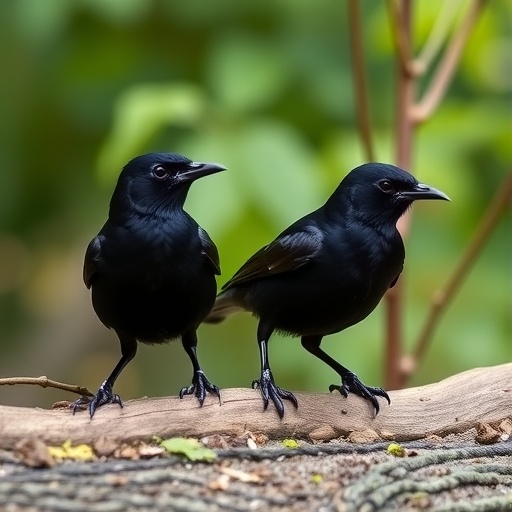Employing a cohort of captive Eurasian blackbirds, Agliani, Visser, Marshall, and colleagues orchestrated controlled inoculations with a characterized USUV strain, carefully monitoring clinical manifestations and virological parameters over successive time points. This approach enabled the team to bypass confounding factors typical of field observations, such as co-infections and environmental stressors, thereby yielding unambiguous data on viral tropism and host susceptibility. Detailed histopathological assessments coupled with quantitative PCR analyses revealed a multi-faceted infection profile, with initial viral replication prominently occurring in primary lymphoid tissues and the central nervous system, followed by systemic dissemination.
.adsslot_f3RHAFDxTS{ width:728px !important; height:90px !important; }
@media (max-width:1199px) { .adsslot_f3RHAFDxTS{ width:468px !important; height:60px !important; } }
@media (max-width:767px) { .adsslot_f3RHAFDxTS{ width:320px !important; height:50px !important; } }
ADVERTISEMENT
One particularly notable finding was the preferential targeting of neural tissues by USUV, a characteristic shared with neurotropic flaviviruses, which underpins the neurological symptoms observed in infected blackbirds. The study meticulously documents encephalitis-like lesions, neuronal necrosis, and microglial activation, signifying a robust neuroimmune response. These neuropathological hallmarks coincide with clinical signs including lethargy, impaired motor coordination, and altered behavioral patterns—indicative of substantial viral neurovirulence. Such neural invasion not only impairs individual bird survival but may alter population dynamics through increased mortality and reduced reproductive success.
Beyond neuropathology, the systemic nature of the infection was illustrated by viremia and evidence of viral presence in multiple organs like the spleen, liver, and kidneys. The investigators’ molecular diagnostic tools traced viral RNA copies that peaked days post-infection and gradually waned as adaptive immunity presumably mounted. Interestingly, immunohistochemical staining exposed marked infiltration of inflammatory cells and upregulation of antiviral cytokines, suggesting an interplay of innate and adaptive immune mechanisms attempting to curtail viral propagation. These immune signatures provide a blueprint for future studies aimed at vaccine development or therapeutics targeting USUV in avifauna.
In terms of ecological impact, the study articulates the broader consequences of USUV emergence on bird communities and biodiversity. Eurasian blackbirds, ubiquitous across urban and rural landscapes, offer an accessible yet sensitive sentinel species whose health reflects environmental viral pressures. The observed morbidity and mortality patterns indicate potential population declines, with cascading effects on predator-prey dynamics, seed dispersal, and insect population control where blackbirds play integral roles. Recognizing the virus’s ecological footprint is fundamental to conservation biology and ecosystem management, especially in an era marked by accelerating climate change and habitat fragmentation which can exacerbate pathogen spread.
The research also contributes to the ongoing discourse on how flaviviruses evolve in new ecological niches. Through genomic sequencing and viral phenotyping, the authors document subtle genetic drift within the tested USUV strain, hinting at adaptive mutations that may enhance infectivity or virulence in European avifauna. Such evolutionary plasticity emphasizes the necessity for sustained molecular surveillance to identify emergent strains with pandemic potential. Moreover, understanding these evolutionary trajectories aids in anticipating the virus’s response to environmental pressures, including vector dynamics modulated by temperature fluctuations and human land use.
From a methodological perspective, the study exemplifies the value of integrative virological research combining in vivo infection models with cutting-edge molecular diagnostics and immunopathology. By bridging experimental virology, neurobiology, and ecology, the authors present a comprehensive framework that other researchers can replicate and refine for studying emerging zoonotic viruses. This multidisciplinary approach is paramount in capturing the complex host-pathogen interactions that underpin disease emergence and transmission dynamics.
Importantly, the study also raises ethical considerations pertinent to experimental wildlife research. The use of Eurasian blackbirds in controlled infection studies demands meticulous welfare protocols and justification to balance scientific gains against animal welfare. The authors’ transparent reporting of morbidity endpoints and humane euthanasia practices sets a commendable precedent for future investigations. Such ethical rigor reinforces public trust and enhances the credibility of experimental disease ecology as a discipline.
Subject of Research: Experimental infection and pathogenesis of Usutu virus in Eurasian blackbirds (Turdus merula)
Article Title: Experimental Usutu virus infection in Eurasian blackbirds (Turdus merula)
Article References:
Agliani, G., Visser, I., Marshall, E.M. et al. Experimental Usutu virus infection in Eurasian blackbirds (Turdus merula). npj Viruses 3, 51 (2025). https://doi.org/10.1038/s44298-025-00133-w
Image Credits: AI Generated
Tags: avian immune responses to flavivirusecological implications of USUVemerging arboviruses in Europeepidemiological consequences of USUVEurasian blackbird disease ecologyexperimental infection models in virologymonitoring strategies for Usutu viruspathogenic mechanisms of Usutu virusspillover risks of flavivirusUsutu virus infection in blackbirdsviral pathogenesis in birdswildlife disease research





